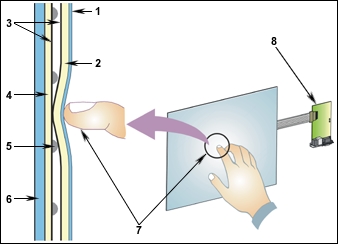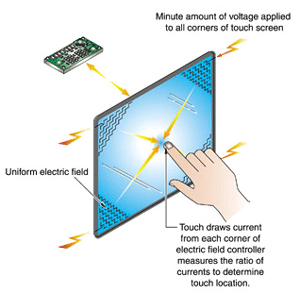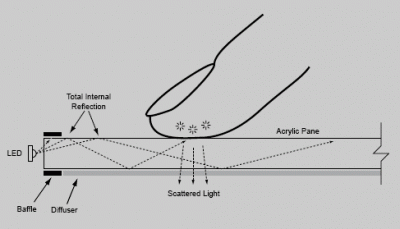Okay, but how do touch screens actually work?
Swipe: verb; the act of moving one’s finger across a touch screen.
Allison T. McCann • January 17, 2012
I recently overheard a woman on the subway telling her friend that her toddler “swipes” everything in their house – the coffee table, books, plates and even her own mother, trying to make her disappear like an image on a touch screen. The story got me thinking that for many of us, our knowledge of what’s going on behind that glossy display isn’t much more than a toddler’s.
Before I started researching how touch screens worked, I figured there was one universal technology behind the “swipable” phenomenon. Instead it turns out there are half a dozen, and more being researched every day. The two most commonly used systems are resistive and capacitive touch screens. For the sake of simplicity, I will focus here on these two systems and finish with where experts think touch screen technology is headed.
1. Resistive
These are the most basic and common touch screens, the ones used at ATMs and supermarkets, that require an electronic signature with that small grey pen. These screens literally “resist” your touch; if you press hard enough you can feel the screen bend slightly. This is what makes resistive screens work – two electrically conductive layers bending to touch one another, as in this picture:

Resistive touch screen technology [Image Credit: Chassis Plans]
One of those thin yellow layers is resistive and the other is conductive, separated by a gap of tiny dots called spacers to keep the two layers apart until you touch it. (A thin, scratch-resistant blue layer on top completes the package.) An electrical current runs through those yellow layers at all times, but when your finger hits the screen the two are pressed together and the electrical current changes at the point of contact. The software recognizes a change in the current at these coordinates and carries out the function that corresponds with that spot.
Resistive touch screens are durable and consistent, but they’re harder to read because the multiple layers reflect more ambient light. They also can only handle one touch at a time – ruling out, for example, the two-finger zoom on an iPhone. That’s why high-end devices are much more likely to use capacitive touchscreens that detect anything that conducts electricity.
2. Capacitive
Unlike resistive touch screens, capacitive screens do not use the pressure of your finger to create a change in the flow of electricity. Instead, they work with anything that holds an electrical charge – including human skin. (Yes, we are comprised of atoms with positive and negative charges!) Capacitive touch screens are constructed from materials like copper or indium tin oxide that store electrical charges in an electrostatic grid of tiny wires, each smaller than a human hair.

Capacitive touch screen technology [Image credit: Electrotest]
There are two main types of capacitive touch screens – surface and projective. Surface capacitive uses sensors at the corners and a thin evenly distributed film across the surface (as pictured above) whereas projective capacitive uses a grid of rows and columns with a separate chip for sensing, explained Matt Rosenthal, an embedded project manager at Touch Revolution. In both instances, when a finger hits the screen a tiny electrical charge is transferred to the finger to complete the circuit, creating a voltage drop on that point of the screen. (This is why capacitive screens don’t work when you wear gloves; cloth does not conduct electricity, unless it is fitted with conductive thread.) The software processes the location of this voltage drop and orders the ensuing action. (If you’re still confused, watch this video.)
3. What’s next? Sizing Up
Newer touch screen technologies are under development, but capacitive touch remains the industry standard for now. The biggest challenge with touch screens is developing them for larger surfaces – the electrical fields of larger screens often interfere with its sensing capability.
Software engineers from Perceptive Pixel, which designs multi-touch screens, is using a technology called frustrated total internal reflection (FTRI) for their larger screens, which are as big as 82-inches. When you touch an FTRI screen you scatter light – and several cameras on the back of the screen detect this light as an optical change, just as a capacitive touch screen detects a change in electrical current.

Frustrated total internal reflection [Image Credit: Jeff Han Laboratory, formerly NYU now Perceptive Pixel]
82 inches? That’s the perfect size for a swipeable coffee table.
113 Comments
I’m also kind of wondering now if one could design a screen where voltage spikes were detected and the local voltage was dead? Wud that save battery? Would they be called inductive screens?
My Nexus 5’s left side of the screen fas stopped working. I dont understand if the voltage change is taken from the coeners why. Can you help. I have read something about a digitizer but dont quite understand. Must be a chip. Thank you DT
Decent
Thanks for posting this. This was very helpful for me. I learned about capacitive touch screens from this post. Thanks
So I am very confused talking this how can work performed
Touch screen? Today I concerned thank you
I’ve always wondered how touch screen works. Thanks for the explanation!
Thanks for this post, makes easy sense
I have been wondering how screen touch works.Thanks for the enlightenment
Nice information, you explained working of touch screen comprehensively. But i have one small doubt. How screens recognize the object, i mean how they recognize whether it is a finger or some other object. Please reply me.
Hi Allison,
How did you know that i was looking for this information.. really i loved your article and thanks a lot. This is my request to please write about multi touch technologies. Hope will hear from you soon. Keep it up mate.
I found this extremely helpful! Thank you! I was writing a research report on how touch screens work and this was exactly what I needed. I don’t know I can thank you enough.
Thanks for giving my 9th grade class a new assignment. #Sarcasm af
As you said capacitive touch display works with anything that conducts electicity but what about metels… they conduct electricity tooo… but if we tried to use some metel which conducts electricity well instead of our skin, the touch screen doesn’t work… why??? I wany the answer soon…. im tooo impatient to know that…
Cell phones recognise the size of what is touching the screen.
Thanks for this help i need this in my life
Thank you very much for the insight.. but I still wonder, if these screens work by detecting voltage drops caused by your hands coming in contact with the screen, why do phone screens with protective glass screen guards still work?
Thanks Allison for putting together this article. I feel better informed. Are there several suppliers for the tech.. or do each company Apple Android develop the next generation of touch screens in house?
Well explained and I got some stuff here. Thank you very much and keep posting.
It’s a wonderful device who invented it for the first time.
I have very dry skin and my fire tablet does not recognize my touch. Is there anything I can do to increase the conductivity of my finger that won’t be transferred to the screen. TY
Very helpful!! Learned something today
In capicitive touch screen, how does circuit complete, when there is a screen guard (I think it’s totally made of plastic)?
Great, eye-opening & simple to understand article!
Chemeli,
The chip that controls the touch screen “scans” along, selecting in turn each column of the x axis, then reads a signal from the y axis that is (roughly) zero if not touched, or a number proportional to the height if there is a touch. The values of the x and y are returned to the software, along with a value for z, which is how hard the point has been pressed, derived from the resistance at the pressed position.
Hi,
I would like some advice regarding how to go about purchasing a touch screen for display in a visitor center. This is a small venue, which caters to families. We would like to install something that would allow folks to access information about the natural environment in our area.
We are starting from scratch. We don’t have a great deal of money to invest, however, we do have experts to provide content. We need advice on the platform that would be best, the software that is the most bullet proof (small children will be using it) and the best low priced screen. Can you point me to a source that will not try to sell me something, but will suggest the best options?
Thank you,
Leslye Mogford
will a touch screen work if my fingers are cold and/or dry i.e., no oils or moisture.
As you said capacitive touch display works with anything that conducts electicity but what about metels… they conduct electricity tooo… but if we tried to use some metel which conducts electricity well instead of our skin, the touch screen doesn’t work. I’ve this same doubt. Reply fast. Email me or anything….
Great , I didn’t Know about touch screens ,but this article helped me understand more about it.
thanks
So how come the hollow rubber tipped “pens” work on the Capacitive screens of my iPhone and iPad – if hollow-rubber is actually insulation against electrical charge and stops a circuit being formed?
Could I use – and get the improved precision & control of – a rubber pencil? IE a pencil that has rubber through the middle – not lead.
Overall the capacitance part of the explanation requires further explanation. I believe the system generally works by changing the capacitance of the screen at different locations as you touch it So capacitance can be changed by inducing an electrical charge or having the electrical charge density change because your finger is inducing that particular spot. So it is different than conducting the electrical charge. Just kind of my guessing how it works Maybe similar to a feild effect transistor (FET)
But maybe that is the next best thing. Field effect touch screen.
Not more than a toddler! Very true. That’s to the extend l knew about touch screens before l read this. I’d like to think l’m the man of science and not knowing anything about these gadgets -l’m using right now to write this- was kind of nuisance for me. Now l feel confident enough to talk about this in the company of friends the next time we have a discussion in a café and l certainly owe that to you madam. Thank you so much.
All around clarified and I got some stuff here. Much thanks and continue posting.
Extraordinary, I didn’t think about touch screens, however, this article helped me see more about it.
much appreciated
Great, well explained article! It’s always more appreciative of the technology if one knows how it works. BTW: I think it’s ‘FTIR’ technology.
You can use a apple skin on capacitive touchscreen.
That cleared the cloud…Thanks mate!
thx
I’m glad with your explaination..but I have a doubt..and I want it to clear from your explaination..u said that capacitive screens works on capacitive touch…that works with anything holds electric charge right..I have tried it using my fingers on my mobile screen…it works ..and I ve tried the same using my charger connector wire…it doesn’t work…but here comes the interesting part..when I plugged my connect or to my phone and tried the same with the screen using the connector wire..it surprisingly worked….as we know that connector’s outer layer is made of some kind of plastic which is bad conductor and cannot hold charge..then how does this touch worked..?
Thanks for your information….ALLISON T. MCCANN
I think there is a loop in the explanation since I tried using a cloth which is an insulator to swipe the screen and it worked
Thank you Allison, well explained
Thank you for the article. I already knew the basics and principles of action for the two types of touch screens but found the diagrams you supplied (especially for capacitive and FTRI) helped to further my understanding.
With specific commercial applications in mind for incorporating this type of technology in an invention I am currently developing, I am seeking to delve much deeper into the subject but unfortunately found no references to research materials supplied. (Also, your “video” link does not appear to link to any video but to a site for lawyers instead.)
Thank you very much for your article, I understand how the resistive touch screen works.
Do other currents, from other devices, cause interruptions in the grid?
Thank you for this knowledge which has satisfies my all queries
Very helpful
To clean the screen and remove viruses, if alcohol wipes are not available, are kitchen antibac wipes safe to use on the screen?
A point of detail. We are not comprised of atoms. We are composed of atoms and atoms comprise us.
Thank you so much for the post and clearing concept about this topic. Such a good article and it’s a amazing.
This was a good and crisp read, at the same time brief and descriptive. Great article.